Sociological Factors: A Literature Review
VerifiedAdded on 2020/02/12
|15
|4078
|87
AI Summary
This literature review examines the influence of sociological factors on diverse phenomena. It delves into topics such as consumer behavior, self-disclosure on social media, mental health conditions, and even superstitions. The assigned readings explore these themes through various research lenses, providing insights into how societal structures and dynamics shape individual actions and experiences.
Contribute Materials
Your contribution can guide someone’s learning journey. Share your
documents today.
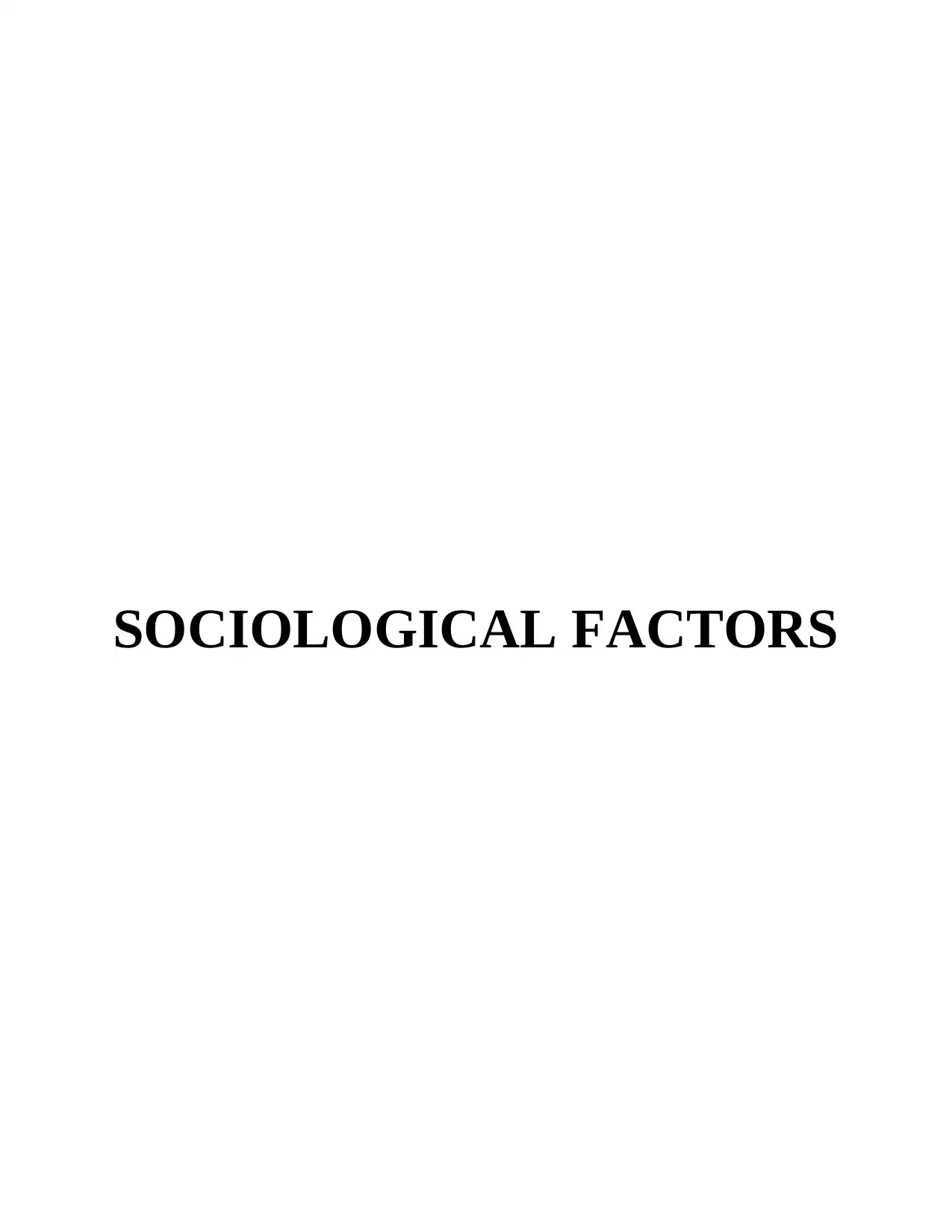
SOCIOLOGICAL FACTORS
Secure Best Marks with AI Grader
Need help grading? Try our AI Grader for instant feedback on your assignments.
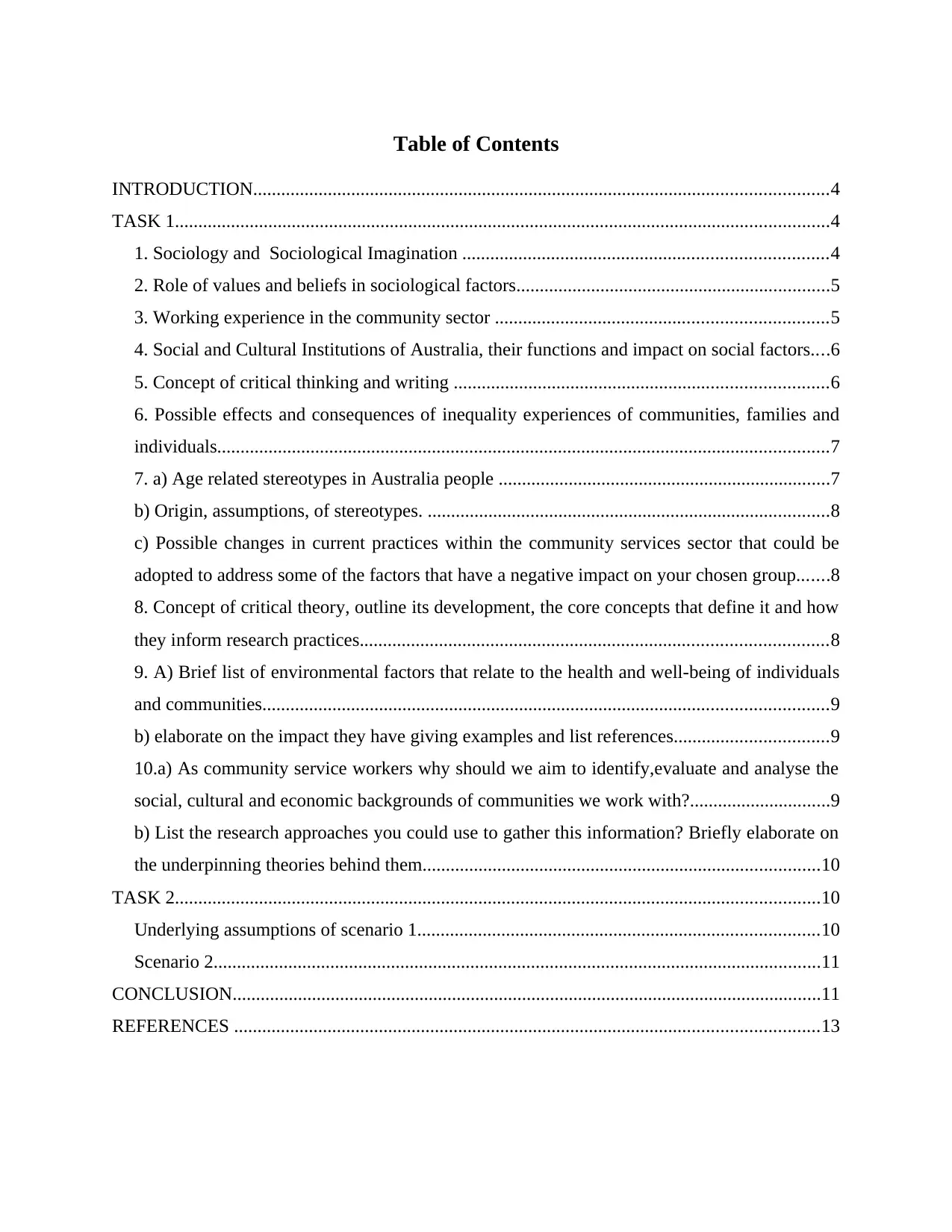
Table of Contents
INTRODUCTION...........................................................................................................................4
TASK 1............................................................................................................................................4
1. Sociology and Sociological Imagination ..............................................................................4
2. Role of values and beliefs in sociological factors...................................................................5
3. Working experience in the community sector .......................................................................5
4. Social and Cultural Institutions of Australia, their functions and impact on social factors....6
5. Concept of critical thinking and writing ................................................................................6
6. Possible effects and consequences of inequality experiences of communities, families and
individuals...................................................................................................................................7
7. a) Age related stereotypes in Australia people .......................................................................7
b) Origin, assumptions, of stereotypes. ......................................................................................8
c) Possible changes in current practices within the community services sector that could be
adopted to address some of the factors that have a negative impact on your chosen group.......8
8. Concept of critical theory, outline its development, the core concepts that define it and how
they inform research practices....................................................................................................8
9. A) Brief list of environmental factors that relate to the health and well-being of individuals
and communities.........................................................................................................................9
b) elaborate on the impact they have giving examples and list references.................................9
10.a) As community service workers why should we aim to identify,evaluate and analyse the
social, cultural and economic backgrounds of communities we work with?..............................9
b) List the research approaches you could use to gather this information? Briefly elaborate on
the underpinning theories behind them.....................................................................................10
TASK 2..........................................................................................................................................10
Underlying assumptions of scenario 1......................................................................................10
Scenario 2..................................................................................................................................11
CONCLUSION..............................................................................................................................11
REFERENCES .............................................................................................................................13
INTRODUCTION...........................................................................................................................4
TASK 1............................................................................................................................................4
1. Sociology and Sociological Imagination ..............................................................................4
2. Role of values and beliefs in sociological factors...................................................................5
3. Working experience in the community sector .......................................................................5
4. Social and Cultural Institutions of Australia, their functions and impact on social factors....6
5. Concept of critical thinking and writing ................................................................................6
6. Possible effects and consequences of inequality experiences of communities, families and
individuals...................................................................................................................................7
7. a) Age related stereotypes in Australia people .......................................................................7
b) Origin, assumptions, of stereotypes. ......................................................................................8
c) Possible changes in current practices within the community services sector that could be
adopted to address some of the factors that have a negative impact on your chosen group.......8
8. Concept of critical theory, outline its development, the core concepts that define it and how
they inform research practices....................................................................................................8
9. A) Brief list of environmental factors that relate to the health and well-being of individuals
and communities.........................................................................................................................9
b) elaborate on the impact they have giving examples and list references.................................9
10.a) As community service workers why should we aim to identify,evaluate and analyse the
social, cultural and economic backgrounds of communities we work with?..............................9
b) List the research approaches you could use to gather this information? Briefly elaborate on
the underpinning theories behind them.....................................................................................10
TASK 2..........................................................................................................................................10
Underlying assumptions of scenario 1......................................................................................10
Scenario 2..................................................................................................................................11
CONCLUSION..............................................................................................................................11
REFERENCES .............................................................................................................................13
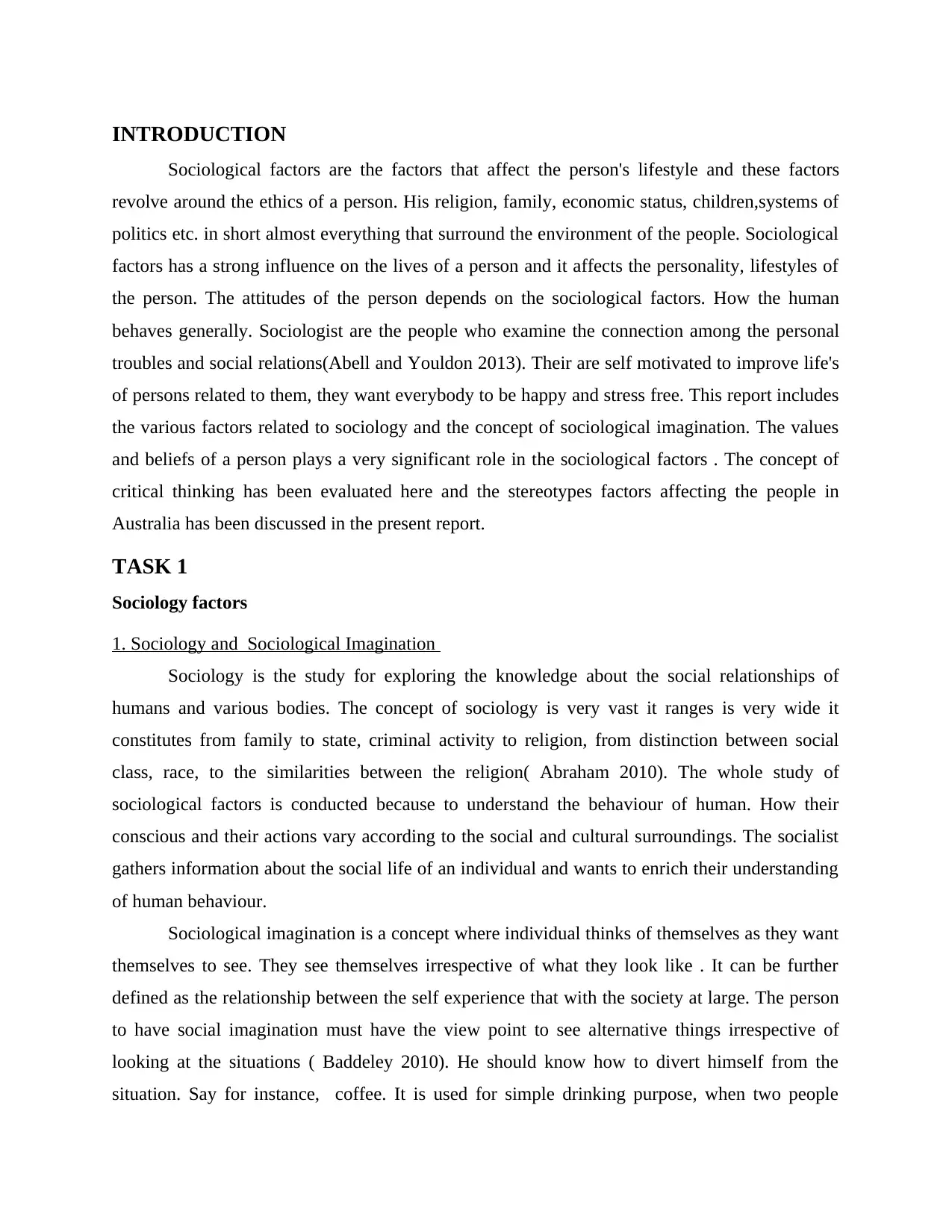
INTRODUCTION
Sociological factors are the factors that affect the person's lifestyle and these factors
revolve around the ethics of a person. His religion, family, economic status, children,systems of
politics etc. in short almost everything that surround the environment of the people. Sociological
factors has a strong influence on the lives of a person and it affects the personality, lifestyles of
the person. The attitudes of the person depends on the sociological factors. How the human
behaves generally. Sociologist are the people who examine the connection among the personal
troubles and social relations(Abell and Youldon 2013). Their are self motivated to improve life's
of persons related to them, they want everybody to be happy and stress free. This report includes
the various factors related to sociology and the concept of sociological imagination. The values
and beliefs of a person plays a very significant role in the sociological factors . The concept of
critical thinking has been evaluated here and the stereotypes factors affecting the people in
Australia has been discussed in the present report.
TASK 1
Sociology factors
1. Sociology and Sociological Imagination
Sociology is the study for exploring the knowledge about the social relationships of
humans and various bodies. The concept of sociology is very vast it ranges is very wide it
constitutes from family to state, criminal activity to religion, from distinction between social
class, race, to the similarities between the religion( Abraham 2010). The whole study of
sociological factors is conducted because to understand the behaviour of human. How their
conscious and their actions vary according to the social and cultural surroundings. The socialist
gathers information about the social life of an individual and wants to enrich their understanding
of human behaviour.
Sociological imagination is a concept where individual thinks of themselves as they want
themselves to see. They see themselves irrespective of what they look like . It can be further
defined as the relationship between the self experience that with the society at large. The person
to have social imagination must have the view point to see alternative things irrespective of
looking at the situations ( Baddeley 2010). He should know how to divert himself from the
situation. Say for instance, coffee. It is used for simple drinking purpose, when two people
Sociological factors are the factors that affect the person's lifestyle and these factors
revolve around the ethics of a person. His religion, family, economic status, children,systems of
politics etc. in short almost everything that surround the environment of the people. Sociological
factors has a strong influence on the lives of a person and it affects the personality, lifestyles of
the person. The attitudes of the person depends on the sociological factors. How the human
behaves generally. Sociologist are the people who examine the connection among the personal
troubles and social relations(Abell and Youldon 2013). Their are self motivated to improve life's
of persons related to them, they want everybody to be happy and stress free. This report includes
the various factors related to sociology and the concept of sociological imagination. The values
and beliefs of a person plays a very significant role in the sociological factors . The concept of
critical thinking has been evaluated here and the stereotypes factors affecting the people in
Australia has been discussed in the present report.
TASK 1
Sociology factors
1. Sociology and Sociological Imagination
Sociology is the study for exploring the knowledge about the social relationships of
humans and various bodies. The concept of sociology is very vast it ranges is very wide it
constitutes from family to state, criminal activity to religion, from distinction between social
class, race, to the similarities between the religion( Abraham 2010). The whole study of
sociological factors is conducted because to understand the behaviour of human. How their
conscious and their actions vary according to the social and cultural surroundings. The socialist
gathers information about the social life of an individual and wants to enrich their understanding
of human behaviour.
Sociological imagination is a concept where individual thinks of themselves as they want
themselves to see. They see themselves irrespective of what they look like . It can be further
defined as the relationship between the self experience that with the society at large. The person
to have social imagination must have the view point to see alternative things irrespective of
looking at the situations ( Baddeley 2010). He should know how to divert himself from the
situation. Say for instance, coffee. It is used for simple drinking purpose, when two people
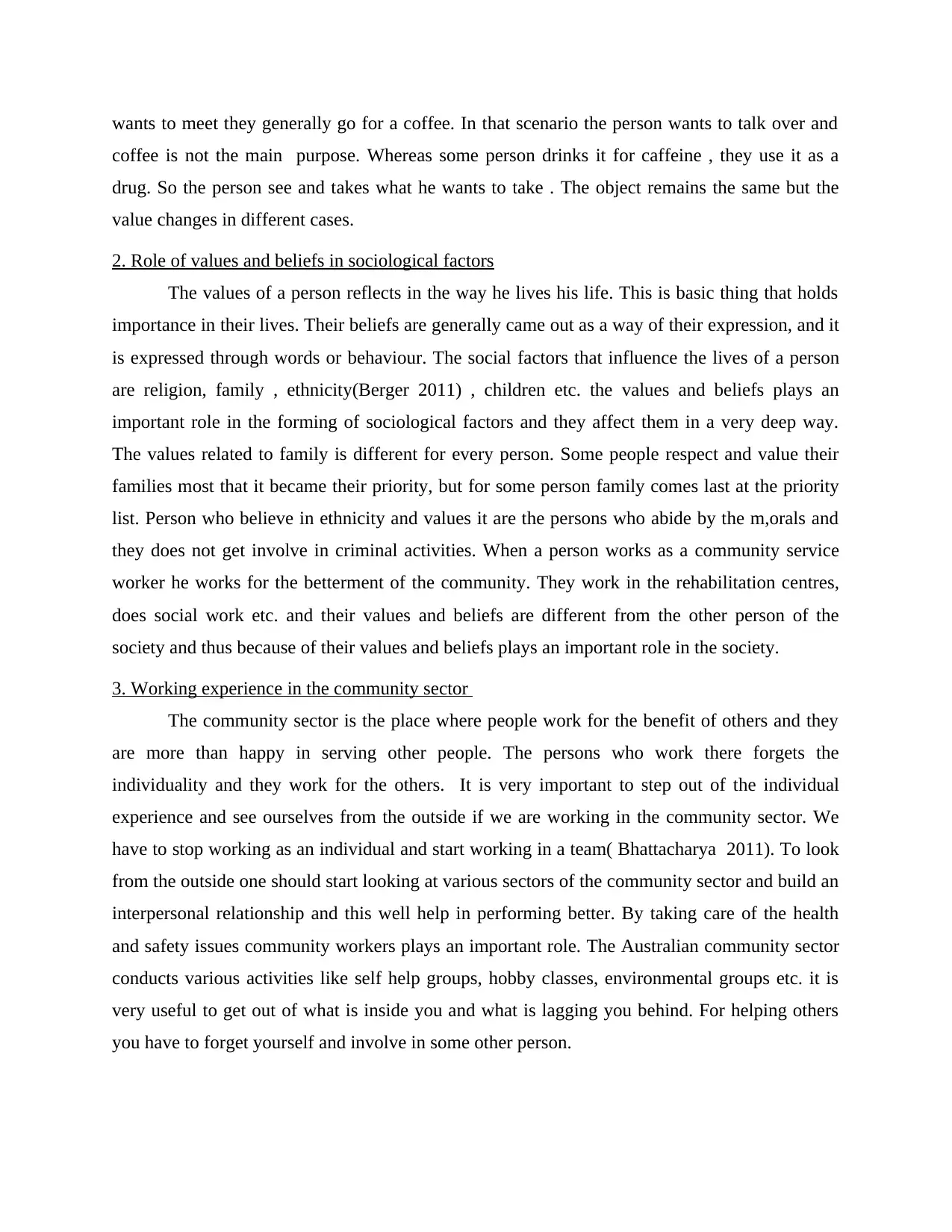
wants to meet they generally go for a coffee. In that scenario the person wants to talk over and
coffee is not the main purpose. Whereas some person drinks it for caffeine , they use it as a
drug. So the person see and takes what he wants to take . The object remains the same but the
value changes in different cases.
2. Role of values and beliefs in sociological factors
The values of a person reflects in the way he lives his life. This is basic thing that holds
importance in their lives. Their beliefs are generally came out as a way of their expression, and it
is expressed through words or behaviour. The social factors that influence the lives of a person
are religion, family , ethnicity(Berger 2011) , children etc. the values and beliefs plays an
important role in the forming of sociological factors and they affect them in a very deep way.
The values related to family is different for every person. Some people respect and value their
families most that it became their priority, but for some person family comes last at the priority
list. Person who believe in ethnicity and values it are the persons who abide by the m,orals and
they does not get involve in criminal activities. When a person works as a community service
worker he works for the betterment of the community. They work in the rehabilitation centres,
does social work etc. and their values and beliefs are different from the other person of the
society and thus because of their values and beliefs plays an important role in the society.
3. Working experience in the community sector
The community sector is the place where people work for the benefit of others and they
are more than happy in serving other people. The persons who work there forgets the
individuality and they work for the others. It is very important to step out of the individual
experience and see ourselves from the outside if we are working in the community sector. We
have to stop working as an individual and start working in a team( Bhattacharya 2011). To look
from the outside one should start looking at various sectors of the community sector and build an
interpersonal relationship and this well help in performing better. By taking care of the health
and safety issues community workers plays an important role. The Australian community sector
conducts various activities like self help groups, hobby classes, environmental groups etc. it is
very useful to get out of what is inside you and what is lagging you behind. For helping others
you have to forget yourself and involve in some other person.
coffee is not the main purpose. Whereas some person drinks it for caffeine , they use it as a
drug. So the person see and takes what he wants to take . The object remains the same but the
value changes in different cases.
2. Role of values and beliefs in sociological factors
The values of a person reflects in the way he lives his life. This is basic thing that holds
importance in their lives. Their beliefs are generally came out as a way of their expression, and it
is expressed through words or behaviour. The social factors that influence the lives of a person
are religion, family , ethnicity(Berger 2011) , children etc. the values and beliefs plays an
important role in the forming of sociological factors and they affect them in a very deep way.
The values related to family is different for every person. Some people respect and value their
families most that it became their priority, but for some person family comes last at the priority
list. Person who believe in ethnicity and values it are the persons who abide by the m,orals and
they does not get involve in criminal activities. When a person works as a community service
worker he works for the betterment of the community. They work in the rehabilitation centres,
does social work etc. and their values and beliefs are different from the other person of the
society and thus because of their values and beliefs plays an important role in the society.
3. Working experience in the community sector
The community sector is the place where people work for the benefit of others and they
are more than happy in serving other people. The persons who work there forgets the
individuality and they work for the others. It is very important to step out of the individual
experience and see ourselves from the outside if we are working in the community sector. We
have to stop working as an individual and start working in a team( Bhattacharya 2011). To look
from the outside one should start looking at various sectors of the community sector and build an
interpersonal relationship and this well help in performing better. By taking care of the health
and safety issues community workers plays an important role. The Australian community sector
conducts various activities like self help groups, hobby classes, environmental groups etc. it is
very useful to get out of what is inside you and what is lagging you behind. For helping others
you have to forget yourself and involve in some other person.
Secure Best Marks with AI Grader
Need help grading? Try our AI Grader for instant feedback on your assignments.
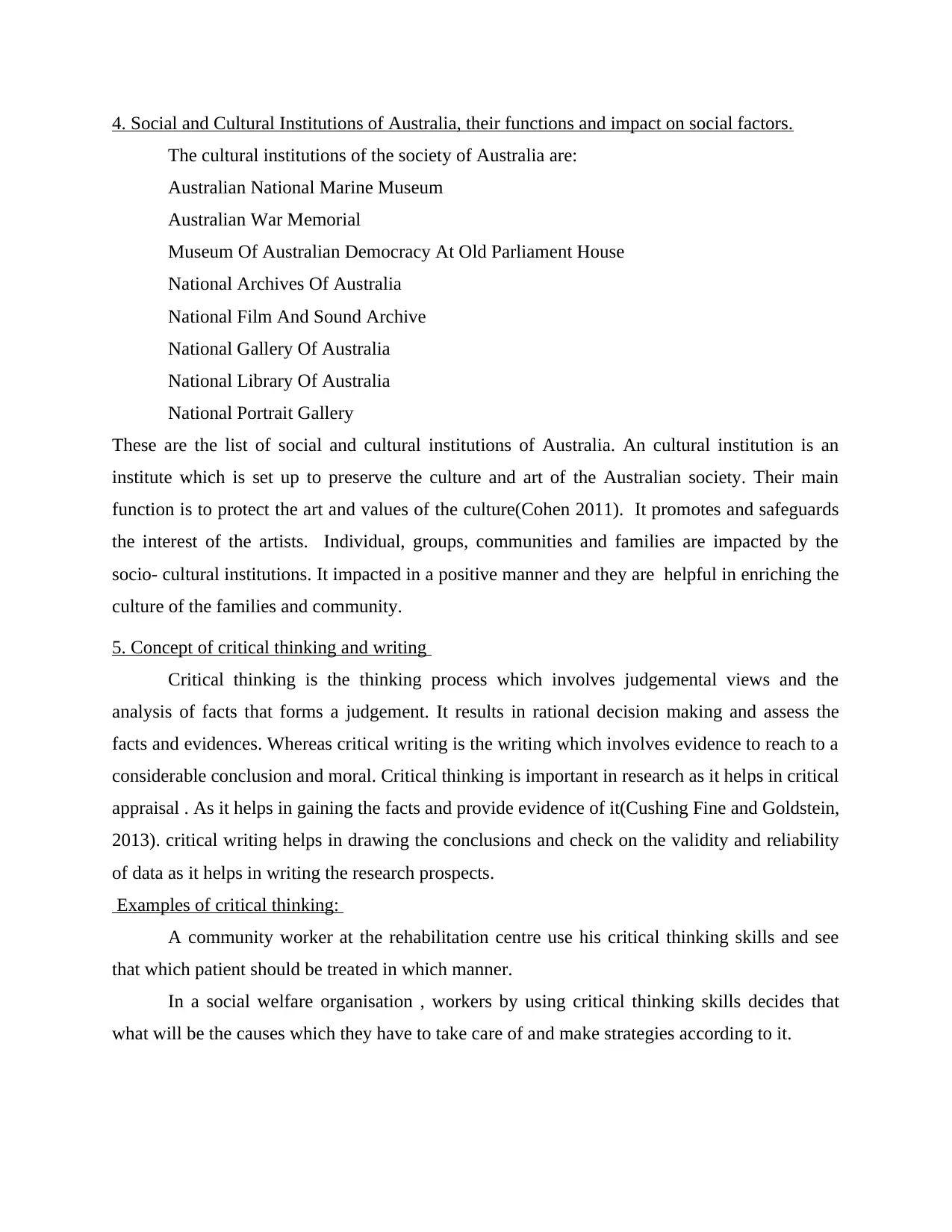
4. Social and Cultural Institutions of Australia, their functions and impact on social factors.
The cultural institutions of the society of Australia are:
Australian National Marine Museum
Australian War Memorial
Museum Of Australian Democracy At Old Parliament House
National Archives Of Australia
National Film And Sound Archive
National Gallery Of Australia
National Library Of Australia
National Portrait Gallery
These are the list of social and cultural institutions of Australia. An cultural institution is an
institute which is set up to preserve the culture and art of the Australian society. Their main
function is to protect the art and values of the culture(Cohen 2011). It promotes and safeguards
the interest of the artists. Individual, groups, communities and families are impacted by the
socio- cultural institutions. It impacted in a positive manner and they are helpful in enriching the
culture of the families and community.
5. Concept of critical thinking and writing
Critical thinking is the thinking process which involves judgemental views and the
analysis of facts that forms a judgement. It results in rational decision making and assess the
facts and evidences. Whereas critical writing is the writing which involves evidence to reach to a
considerable conclusion and moral. Critical thinking is important in research as it helps in critical
appraisal . As it helps in gaining the facts and provide evidence of it(Cushing Fine and Goldstein,
2013). critical writing helps in drawing the conclusions and check on the validity and reliability
of data as it helps in writing the research prospects.
Examples of critical thinking:
A community worker at the rehabilitation centre use his critical thinking skills and see
that which patient should be treated in which manner.
In a social welfare organisation , workers by using critical thinking skills decides that
what will be the causes which they have to take care of and make strategies according to it.
The cultural institutions of the society of Australia are:
Australian National Marine Museum
Australian War Memorial
Museum Of Australian Democracy At Old Parliament House
National Archives Of Australia
National Film And Sound Archive
National Gallery Of Australia
National Library Of Australia
National Portrait Gallery
These are the list of social and cultural institutions of Australia. An cultural institution is an
institute which is set up to preserve the culture and art of the Australian society. Their main
function is to protect the art and values of the culture(Cohen 2011). It promotes and safeguards
the interest of the artists. Individual, groups, communities and families are impacted by the
socio- cultural institutions. It impacted in a positive manner and they are helpful in enriching the
culture of the families and community.
5. Concept of critical thinking and writing
Critical thinking is the thinking process which involves judgemental views and the
analysis of facts that forms a judgement. It results in rational decision making and assess the
facts and evidences. Whereas critical writing is the writing which involves evidence to reach to a
considerable conclusion and moral. Critical thinking is important in research as it helps in critical
appraisal . As it helps in gaining the facts and provide evidence of it(Cushing Fine and Goldstein,
2013). critical writing helps in drawing the conclusions and check on the validity and reliability
of data as it helps in writing the research prospects.
Examples of critical thinking:
A community worker at the rehabilitation centre use his critical thinking skills and see
that which patient should be treated in which manner.
In a social welfare organisation , workers by using critical thinking skills decides that
what will be the causes which they have to take care of and make strategies according to it.
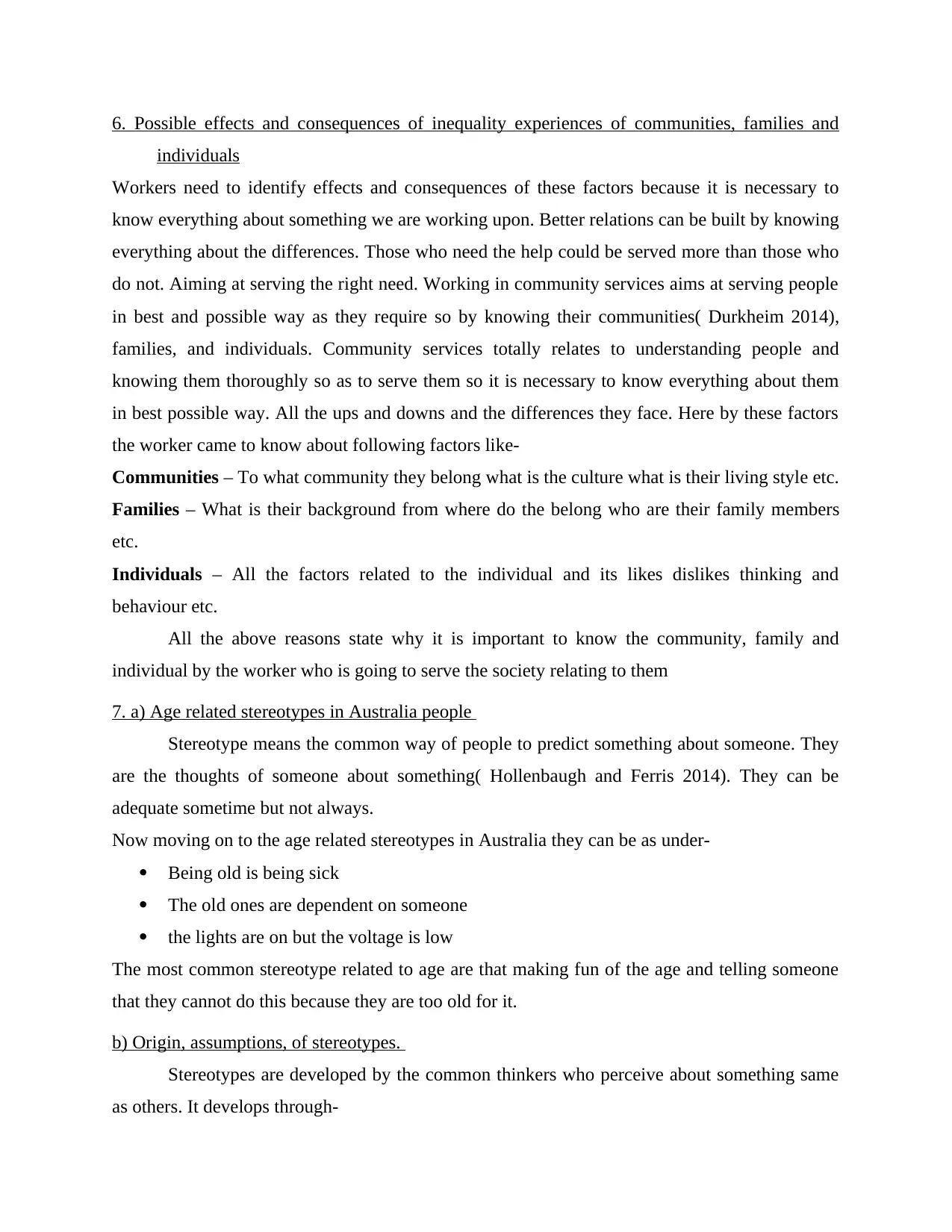
6. Possible effects and consequences of inequality experiences of communities, families and
individuals
Workers need to identify effects and consequences of these factors because it is necessary to
know everything about something we are working upon. Better relations can be built by knowing
everything about the differences. Those who need the help could be served more than those who
do not. Aiming at serving the right need. Working in community services aims at serving people
in best and possible way as they require so by knowing their communities( Durkheim 2014),
families, and individuals. Community services totally relates to understanding people and
knowing them thoroughly so as to serve them so it is necessary to know everything about them
in best possible way. All the ups and downs and the differences they face. Here by these factors
the worker came to know about following factors like-
Communities – To what community they belong what is the culture what is their living style etc.
Families – What is their background from where do the belong who are their family members
etc.
Individuals – All the factors related to the individual and its likes dislikes thinking and
behaviour etc.
All the above reasons state why it is important to know the community, family and
individual by the worker who is going to serve the society relating to them
7. a) Age related stereotypes in Australia people
Stereotype means the common way of people to predict something about someone. They
are the thoughts of someone about something( Hollenbaugh and Ferris 2014). They can be
adequate sometime but not always.
Now moving on to the age related stereotypes in Australia they can be as under-
Being old is being sick
The old ones are dependent on someone
the lights are on but the voltage is low
The most common stereotype related to age are that making fun of the age and telling someone
that they cannot do this because they are too old for it.
b) Origin, assumptions, of stereotypes.
Stereotypes are developed by the common thinkers who perceive about something same
as others. It develops through-
individuals
Workers need to identify effects and consequences of these factors because it is necessary to
know everything about something we are working upon. Better relations can be built by knowing
everything about the differences. Those who need the help could be served more than those who
do not. Aiming at serving the right need. Working in community services aims at serving people
in best and possible way as they require so by knowing their communities( Durkheim 2014),
families, and individuals. Community services totally relates to understanding people and
knowing them thoroughly so as to serve them so it is necessary to know everything about them
in best possible way. All the ups and downs and the differences they face. Here by these factors
the worker came to know about following factors like-
Communities – To what community they belong what is the culture what is their living style etc.
Families – What is their background from where do the belong who are their family members
etc.
Individuals – All the factors related to the individual and its likes dislikes thinking and
behaviour etc.
All the above reasons state why it is important to know the community, family and
individual by the worker who is going to serve the society relating to them
7. a) Age related stereotypes in Australia people
Stereotype means the common way of people to predict something about someone. They
are the thoughts of someone about something( Hollenbaugh and Ferris 2014). They can be
adequate sometime but not always.
Now moving on to the age related stereotypes in Australia they can be as under-
Being old is being sick
The old ones are dependent on someone
the lights are on but the voltage is low
The most common stereotype related to age are that making fun of the age and telling someone
that they cannot do this because they are too old for it.
b) Origin, assumptions, of stereotypes.
Stereotypes are developed by the common thinkers who perceive about something same
as others. It develops through-
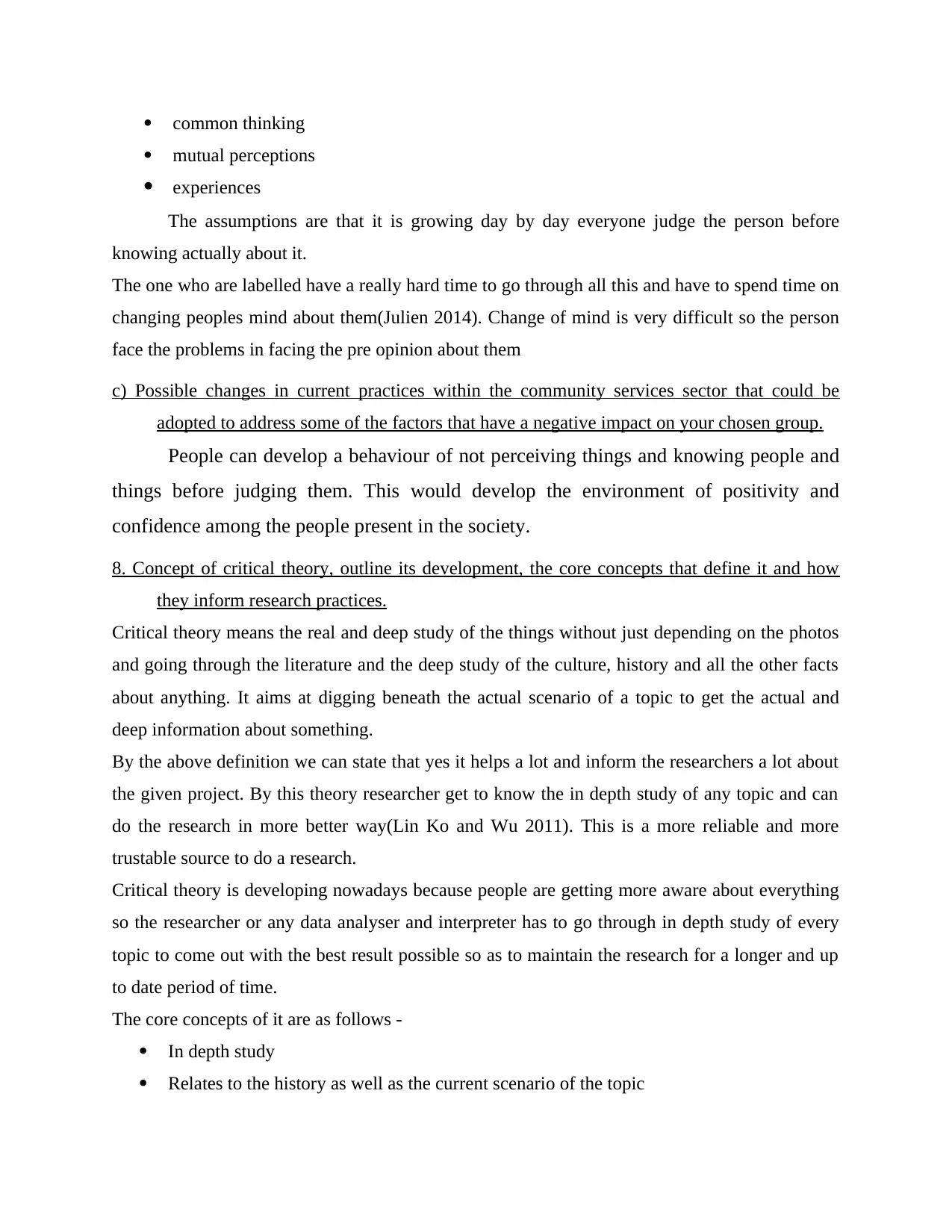
common thinking
mutual perceptions
experiences
The assumptions are that it is growing day by day everyone judge the person before
knowing actually about it.
The one who are labelled have a really hard time to go through all this and have to spend time on
changing peoples mind about them(Julien 2014). Change of mind is very difficult so the person
face the problems in facing the pre opinion about them
c) Possible changes in current practices within the community services sector that could be
adopted to address some of the factors that have a negative impact on your chosen group.
People can develop a behaviour of not perceiving things and knowing people and
things before judging them. This would develop the environment of positivity and
confidence among the people present in the society.
8. Concept of critical theory, outline its development, the core concepts that define it and how
they inform research practices.
Critical theory means the real and deep study of the things without just depending on the photos
and going through the literature and the deep study of the culture, history and all the other facts
about anything. It aims at digging beneath the actual scenario of a topic to get the actual and
deep information about something.
By the above definition we can state that yes it helps a lot and inform the researchers a lot about
the given project. By this theory researcher get to know the in depth study of any topic and can
do the research in more better way(Lin Ko and Wu 2011). This is a more reliable and more
trustable source to do a research.
Critical theory is developing nowadays because people are getting more aware about everything
so the researcher or any data analyser and interpreter has to go through in depth study of every
topic to come out with the best result possible so as to maintain the research for a longer and up
to date period of time.
The core concepts of it are as follows -
In depth study
Relates to the history as well as the current scenario of the topic
mutual perceptions
experiences
The assumptions are that it is growing day by day everyone judge the person before
knowing actually about it.
The one who are labelled have a really hard time to go through all this and have to spend time on
changing peoples mind about them(Julien 2014). Change of mind is very difficult so the person
face the problems in facing the pre opinion about them
c) Possible changes in current practices within the community services sector that could be
adopted to address some of the factors that have a negative impact on your chosen group.
People can develop a behaviour of not perceiving things and knowing people and
things before judging them. This would develop the environment of positivity and
confidence among the people present in the society.
8. Concept of critical theory, outline its development, the core concepts that define it and how
they inform research practices.
Critical theory means the real and deep study of the things without just depending on the photos
and going through the literature and the deep study of the culture, history and all the other facts
about anything. It aims at digging beneath the actual scenario of a topic to get the actual and
deep information about something.
By the above definition we can state that yes it helps a lot and inform the researchers a lot about
the given project. By this theory researcher get to know the in depth study of any topic and can
do the research in more better way(Lin Ko and Wu 2011). This is a more reliable and more
trustable source to do a research.
Critical theory is developing nowadays because people are getting more aware about everything
so the researcher or any data analyser and interpreter has to go through in depth study of every
topic to come out with the best result possible so as to maintain the research for a longer and up
to date period of time.
The core concepts of it are as follows -
In depth study
Relates to the history as well as the current scenario of the topic
Paraphrase This Document
Need a fresh take? Get an instant paraphrase of this document with our AI Paraphraser
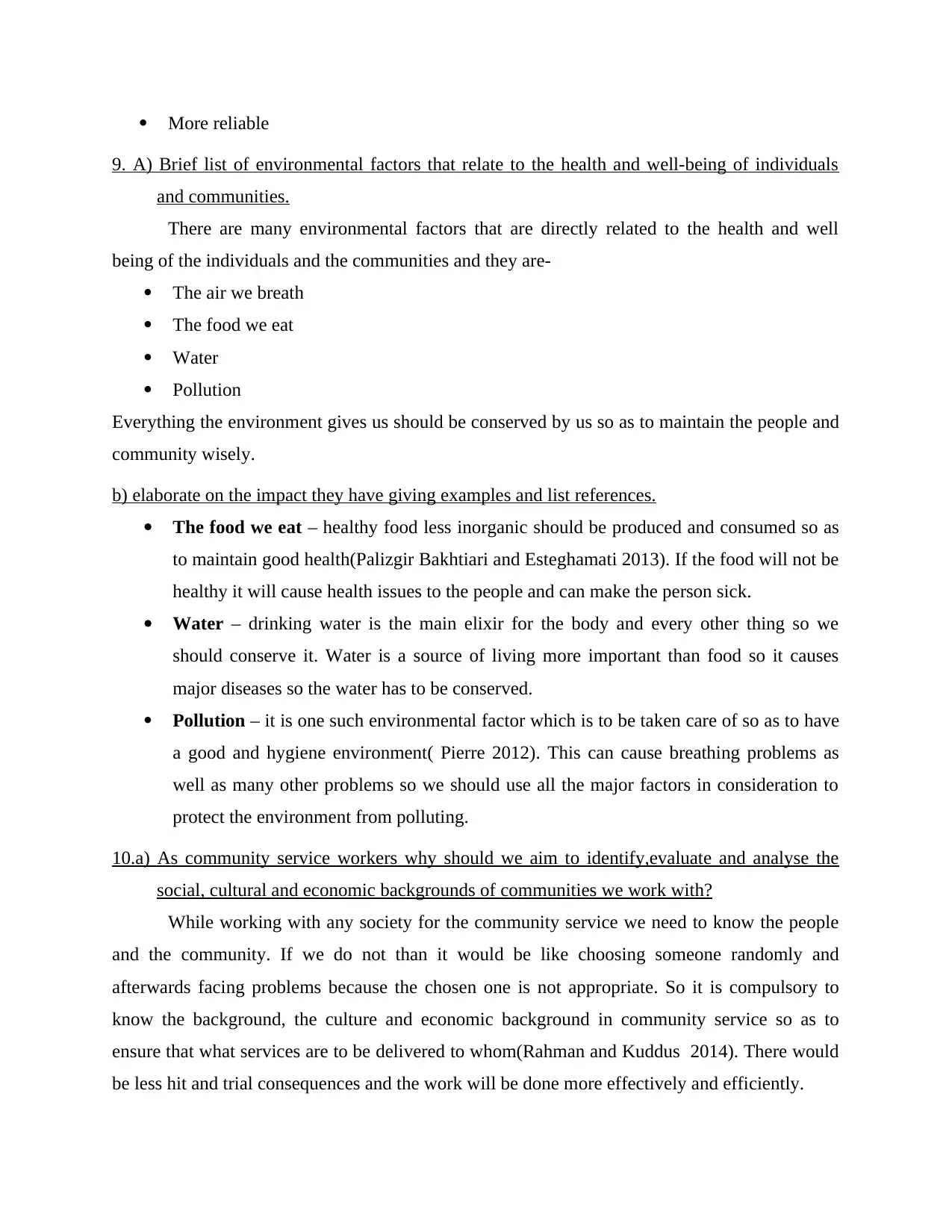
More reliable
9. A) Brief list of environmental factors that relate to the health and well-being of individuals
and communities.
There are many environmental factors that are directly related to the health and well
being of the individuals and the communities and they are-
The air we breath
The food we eat
Water
Pollution
Everything the environment gives us should be conserved by us so as to maintain the people and
community wisely.
b) elaborate on the impact they have giving examples and list references.
The food we eat – healthy food less inorganic should be produced and consumed so as
to maintain good health(Palizgir Bakhtiari and Esteghamati 2013). If the food will not be
healthy it will cause health issues to the people and can make the person sick.
Water – drinking water is the main elixir for the body and every other thing so we
should conserve it. Water is a source of living more important than food so it causes
major diseases so the water has to be conserved.
Pollution – it is one such environmental factor which is to be taken care of so as to have
a good and hygiene environment( Pierre 2012). This can cause breathing problems as
well as many other problems so we should use all the major factors in consideration to
protect the environment from polluting.
10.a) As community service workers why should we aim to identify,evaluate and analyse the
social, cultural and economic backgrounds of communities we work with?
While working with any society for the community service we need to know the people
and the community. If we do not than it would be like choosing someone randomly and
afterwards facing problems because the chosen one is not appropriate. So it is compulsory to
know the background, the culture and economic background in community service so as to
ensure that what services are to be delivered to whom(Rahman and Kuddus 2014). There would
be less hit and trial consequences and the work will be done more effectively and efficiently.
9. A) Brief list of environmental factors that relate to the health and well-being of individuals
and communities.
There are many environmental factors that are directly related to the health and well
being of the individuals and the communities and they are-
The air we breath
The food we eat
Water
Pollution
Everything the environment gives us should be conserved by us so as to maintain the people and
community wisely.
b) elaborate on the impact they have giving examples and list references.
The food we eat – healthy food less inorganic should be produced and consumed so as
to maintain good health(Palizgir Bakhtiari and Esteghamati 2013). If the food will not be
healthy it will cause health issues to the people and can make the person sick.
Water – drinking water is the main elixir for the body and every other thing so we
should conserve it. Water is a source of living more important than food so it causes
major diseases so the water has to be conserved.
Pollution – it is one such environmental factor which is to be taken care of so as to have
a good and hygiene environment( Pierre 2012). This can cause breathing problems as
well as many other problems so we should use all the major factors in consideration to
protect the environment from polluting.
10.a) As community service workers why should we aim to identify,evaluate and analyse the
social, cultural and economic backgrounds of communities we work with?
While working with any society for the community service we need to know the people
and the community. If we do not than it would be like choosing someone randomly and
afterwards facing problems because the chosen one is not appropriate. So it is compulsory to
know the background, the culture and economic background in community service so as to
ensure that what services are to be delivered to whom(Rahman and Kuddus 2014). There would
be less hit and trial consequences and the work will be done more effectively and efficiently.
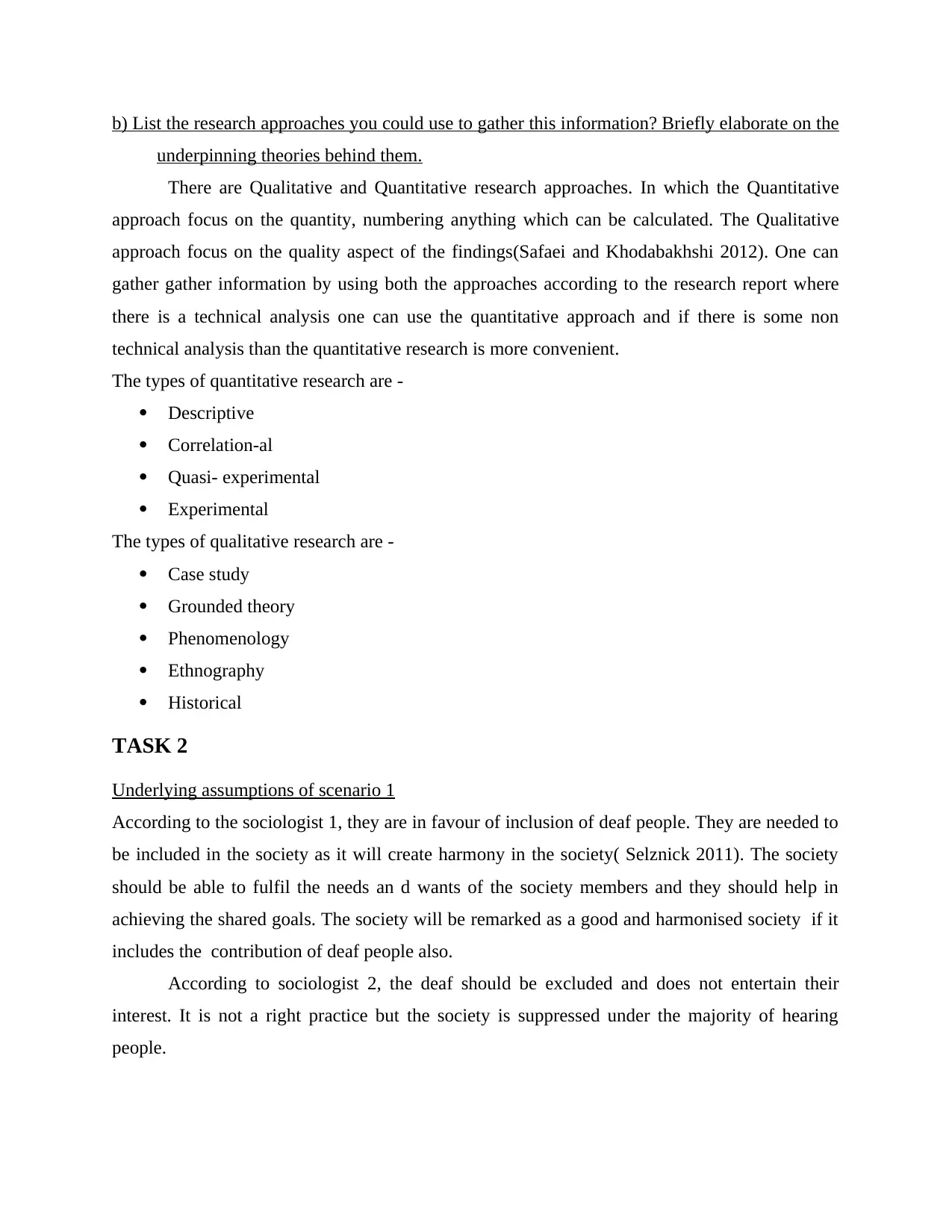
b) List the research approaches you could use to gather this information? Briefly elaborate on the
underpinning theories behind them.
There are Qualitative and Quantitative research approaches. In which the Quantitative
approach focus on the quantity, numbering anything which can be calculated. The Qualitative
approach focus on the quality aspect of the findings(Safaei and Khodabakhshi 2012). One can
gather gather information by using both the approaches according to the research report where
there is a technical analysis one can use the quantitative approach and if there is some non
technical analysis than the quantitative research is more convenient.
The types of quantitative research are -
Descriptive
Correlation-al
Quasi- experimental
Experimental
The types of qualitative research are -
Case study
Grounded theory
Phenomenology
Ethnography
Historical
TASK 2
Underlying assumptions of scenario 1
According to the sociologist 1, they are in favour of inclusion of deaf people. They are needed to
be included in the society as it will create harmony in the society( Selznick 2011). The society
should be able to fulfil the needs an d wants of the society members and they should help in
achieving the shared goals. The society will be remarked as a good and harmonised society if it
includes the contribution of deaf people also.
According to sociologist 2, the deaf should be excluded and does not entertain their
interest. It is not a right practice but the society is suppressed under the majority of hearing
people.
underpinning theories behind them.
There are Qualitative and Quantitative research approaches. In which the Quantitative
approach focus on the quantity, numbering anything which can be calculated. The Qualitative
approach focus on the quality aspect of the findings(Safaei and Khodabakhshi 2012). One can
gather gather information by using both the approaches according to the research report where
there is a technical analysis one can use the quantitative approach and if there is some non
technical analysis than the quantitative research is more convenient.
The types of quantitative research are -
Descriptive
Correlation-al
Quasi- experimental
Experimental
The types of qualitative research are -
Case study
Grounded theory
Phenomenology
Ethnography
Historical
TASK 2
Underlying assumptions of scenario 1
According to the sociologist 1, they are in favour of inclusion of deaf people. They are needed to
be included in the society as it will create harmony in the society( Selznick 2011). The society
should be able to fulfil the needs an d wants of the society members and they should help in
achieving the shared goals. The society will be remarked as a good and harmonised society if it
includes the contribution of deaf people also.
According to sociologist 2, the deaf should be excluded and does not entertain their
interest. It is not a right practice but the society is suppressed under the majority of hearing
people.
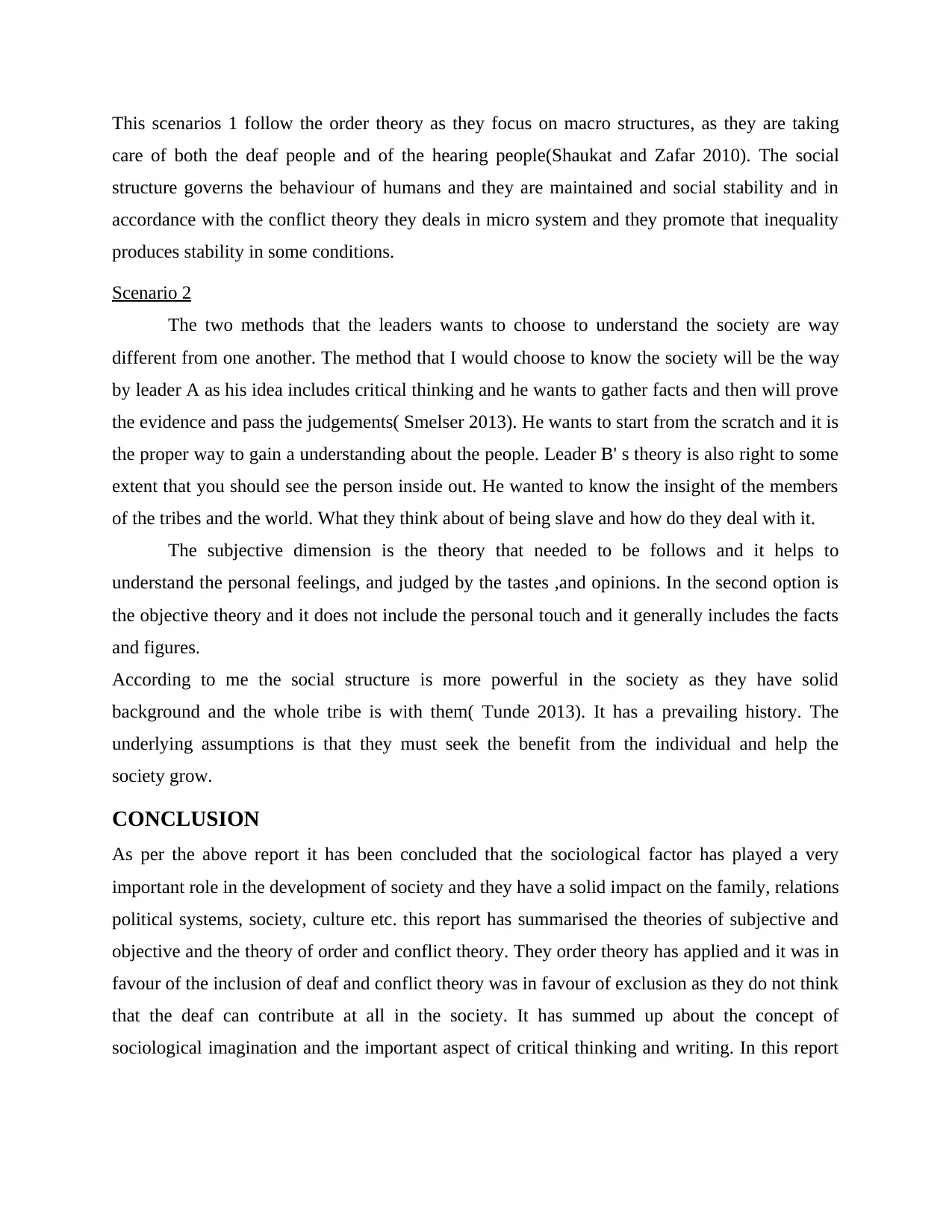
This scenarios 1 follow the order theory as they focus on macro structures, as they are taking
care of both the deaf people and of the hearing people(Shaukat and Zafar 2010). The social
structure governs the behaviour of humans and they are maintained and social stability and in
accordance with the conflict theory they deals in micro system and they promote that inequality
produces stability in some conditions.
Scenario 2
The two methods that the leaders wants to choose to understand the society are way
different from one another. The method that I would choose to know the society will be the way
by leader A as his idea includes critical thinking and he wants to gather facts and then will prove
the evidence and pass the judgements( Smelser 2013). He wants to start from the scratch and it is
the proper way to gain a understanding about the people. Leader B' s theory is also right to some
extent that you should see the person inside out. He wanted to know the insight of the members
of the tribes and the world. What they think about of being slave and how do they deal with it.
The subjective dimension is the theory that needed to be follows and it helps to
understand the personal feelings, and judged by the tastes ,and opinions. In the second option is
the objective theory and it does not include the personal touch and it generally includes the facts
and figures.
According to me the social structure is more powerful in the society as they have solid
background and the whole tribe is with them( Tunde 2013). It has a prevailing history. The
underlying assumptions is that they must seek the benefit from the individual and help the
society grow.
CONCLUSION
As per the above report it has been concluded that the sociological factor has played a very
important role in the development of society and they have a solid impact on the family, relations
political systems, society, culture etc. this report has summarised the theories of subjective and
objective and the theory of order and conflict theory. They order theory has applied and it was in
favour of the inclusion of deaf and conflict theory was in favour of exclusion as they do not think
that the deaf can contribute at all in the society. It has summed up about the concept of
sociological imagination and the important aspect of critical thinking and writing. In this report
care of both the deaf people and of the hearing people(Shaukat and Zafar 2010). The social
structure governs the behaviour of humans and they are maintained and social stability and in
accordance with the conflict theory they deals in micro system and they promote that inequality
produces stability in some conditions.
Scenario 2
The two methods that the leaders wants to choose to understand the society are way
different from one another. The method that I would choose to know the society will be the way
by leader A as his idea includes critical thinking and he wants to gather facts and then will prove
the evidence and pass the judgements( Smelser 2013). He wants to start from the scratch and it is
the proper way to gain a understanding about the people. Leader B' s theory is also right to some
extent that you should see the person inside out. He wanted to know the insight of the members
of the tribes and the world. What they think about of being slave and how do they deal with it.
The subjective dimension is the theory that needed to be follows and it helps to
understand the personal feelings, and judged by the tastes ,and opinions. In the second option is
the objective theory and it does not include the personal touch and it generally includes the facts
and figures.
According to me the social structure is more powerful in the society as they have solid
background and the whole tribe is with them( Tunde 2013). It has a prevailing history. The
underlying assumptions is that they must seek the benefit from the individual and help the
society grow.
CONCLUSION
As per the above report it has been concluded that the sociological factor has played a very
important role in the development of society and they have a solid impact on the family, relations
political systems, society, culture etc. this report has summarised the theories of subjective and
objective and the theory of order and conflict theory. They order theory has applied and it was in
favour of the inclusion of deaf and conflict theory was in favour of exclusion as they do not think
that the deaf can contribute at all in the society. It has summed up about the concept of
sociological imagination and the important aspect of critical thinking and writing. In this report
Secure Best Marks with AI Grader
Need help grading? Try our AI Grader for instant feedback on your assignments.
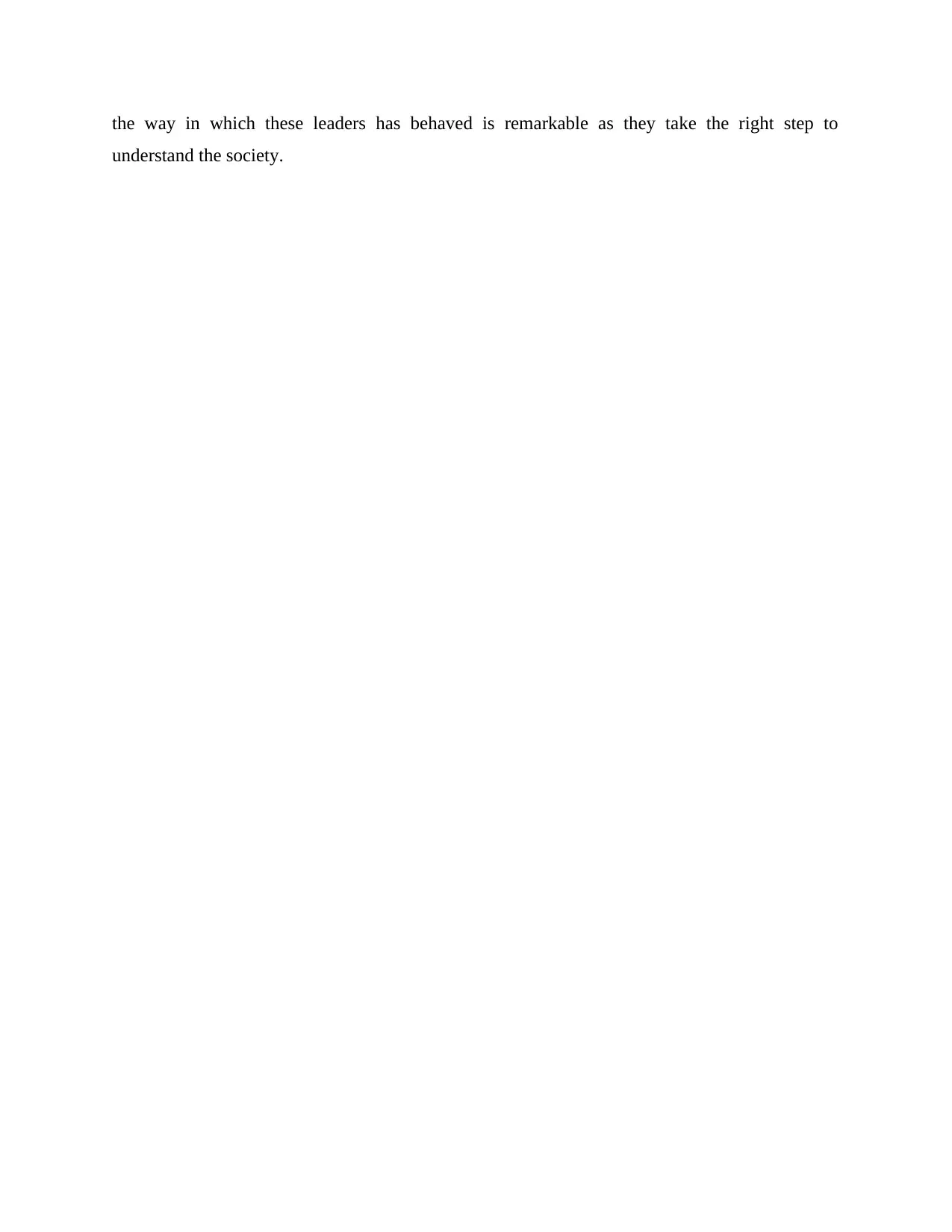
the way in which these leaders has behaved is remarkable as they take the right step to
understand the society.
understand the society.
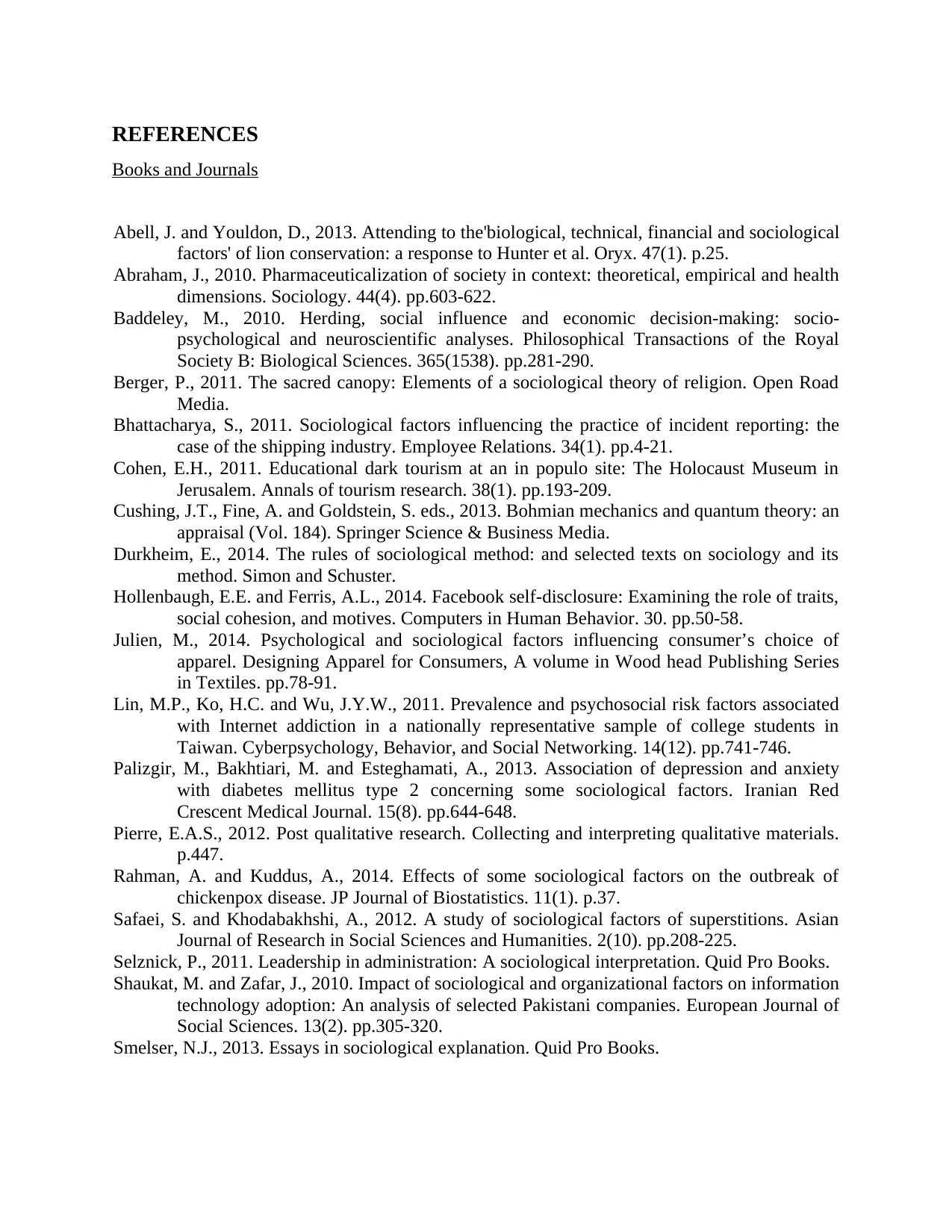
REFERENCES
Books and Journals
Abell, J. and Youldon, D., 2013. Attending to the'biological, technical, financial and sociological
factors' of lion conservation: a response to Hunter et al. Oryx. 47(1). p.25.
Abraham, J., 2010. Pharmaceuticalization of society in context: theoretical, empirical and health
dimensions. Sociology. 44(4). pp.603-622.
Baddeley, M., 2010. Herding, social influence and economic decision-making: socio-
psychological and neuroscientific analyses. Philosophical Transactions of the Royal
Society B: Biological Sciences. 365(1538). pp.281-290.
Berger, P., 2011. The sacred canopy: Elements of a sociological theory of religion. Open Road
Media.
Bhattacharya, S., 2011. Sociological factors influencing the practice of incident reporting: the
case of the shipping industry. Employee Relations. 34(1). pp.4-21.
Cohen, E.H., 2011. Educational dark tourism at an in populo site: The Holocaust Museum in
Jerusalem. Annals of tourism research. 38(1). pp.193-209.
Cushing, J.T., Fine, A. and Goldstein, S. eds., 2013. Bohmian mechanics and quantum theory: an
appraisal (Vol. 184). Springer Science & Business Media.
Durkheim, E., 2014. The rules of sociological method: and selected texts on sociology and its
method. Simon and Schuster.
Hollenbaugh, E.E. and Ferris, A.L., 2014. Facebook self-disclosure: Examining the role of traits,
social cohesion, and motives. Computers in Human Behavior. 30. pp.50-58.
Julien, M., 2014. Psychological and sociological factors influencing consumer’s choice of
apparel. Designing Apparel for Consumers, A volume in Wood head Publishing Series
in Textiles. pp.78-91.
Lin, M.P., Ko, H.C. and Wu, J.Y.W., 2011. Prevalence and psychosocial risk factors associated
with Internet addiction in a nationally representative sample of college students in
Taiwan. Cyberpsychology, Behavior, and Social Networking. 14(12). pp.741-746.
Palizgir, M., Bakhtiari, M. and Esteghamati, A., 2013. Association of depression and anxiety
with diabetes mellitus type 2 concerning some sociological factors. Iranian Red
Crescent Medical Journal. 15(8). pp.644-648.
Pierre, E.A.S., 2012. Post qualitative research. Collecting and interpreting qualitative materials.
p.447.
Rahman, A. and Kuddus, A., 2014. Effects of some sociological factors on the outbreak of
chickenpox disease. JP Journal of Biostatistics. 11(1). p.37.
Safaei, S. and Khodabakhshi, A., 2012. A study of sociological factors of superstitions. Asian
Journal of Research in Social Sciences and Humanities. 2(10). pp.208-225.
Selznick, P., 2011. Leadership in administration: A sociological interpretation. Quid Pro Books.
Shaukat, M. and Zafar, J., 2010. Impact of sociological and organizational factors on information
technology adoption: An analysis of selected Pakistani companies. European Journal of
Social Sciences. 13(2). pp.305-320.
Smelser, N.J., 2013. Essays in sociological explanation. Quid Pro Books.
Books and Journals
Abell, J. and Youldon, D., 2013. Attending to the'biological, technical, financial and sociological
factors' of lion conservation: a response to Hunter et al. Oryx. 47(1). p.25.
Abraham, J., 2010. Pharmaceuticalization of society in context: theoretical, empirical and health
dimensions. Sociology. 44(4). pp.603-622.
Baddeley, M., 2010. Herding, social influence and economic decision-making: socio-
psychological and neuroscientific analyses. Philosophical Transactions of the Royal
Society B: Biological Sciences. 365(1538). pp.281-290.
Berger, P., 2011. The sacred canopy: Elements of a sociological theory of religion. Open Road
Media.
Bhattacharya, S., 2011. Sociological factors influencing the practice of incident reporting: the
case of the shipping industry. Employee Relations. 34(1). pp.4-21.
Cohen, E.H., 2011. Educational dark tourism at an in populo site: The Holocaust Museum in
Jerusalem. Annals of tourism research. 38(1). pp.193-209.
Cushing, J.T., Fine, A. and Goldstein, S. eds., 2013. Bohmian mechanics and quantum theory: an
appraisal (Vol. 184). Springer Science & Business Media.
Durkheim, E., 2014. The rules of sociological method: and selected texts on sociology and its
method. Simon and Schuster.
Hollenbaugh, E.E. and Ferris, A.L., 2014. Facebook self-disclosure: Examining the role of traits,
social cohesion, and motives. Computers in Human Behavior. 30. pp.50-58.
Julien, M., 2014. Psychological and sociological factors influencing consumer’s choice of
apparel. Designing Apparel for Consumers, A volume in Wood head Publishing Series
in Textiles. pp.78-91.
Lin, M.P., Ko, H.C. and Wu, J.Y.W., 2011. Prevalence and psychosocial risk factors associated
with Internet addiction in a nationally representative sample of college students in
Taiwan. Cyberpsychology, Behavior, and Social Networking. 14(12). pp.741-746.
Palizgir, M., Bakhtiari, M. and Esteghamati, A., 2013. Association of depression and anxiety
with diabetes mellitus type 2 concerning some sociological factors. Iranian Red
Crescent Medical Journal. 15(8). pp.644-648.
Pierre, E.A.S., 2012. Post qualitative research. Collecting and interpreting qualitative materials.
p.447.
Rahman, A. and Kuddus, A., 2014. Effects of some sociological factors on the outbreak of
chickenpox disease. JP Journal of Biostatistics. 11(1). p.37.
Safaei, S. and Khodabakhshi, A., 2012. A study of sociological factors of superstitions. Asian
Journal of Research in Social Sciences and Humanities. 2(10). pp.208-225.
Selznick, P., 2011. Leadership in administration: A sociological interpretation. Quid Pro Books.
Shaukat, M. and Zafar, J., 2010. Impact of sociological and organizational factors on information
technology adoption: An analysis of selected Pakistani companies. European Journal of
Social Sciences. 13(2). pp.305-320.
Smelser, N.J., 2013. Essays in sociological explanation. Quid Pro Books.
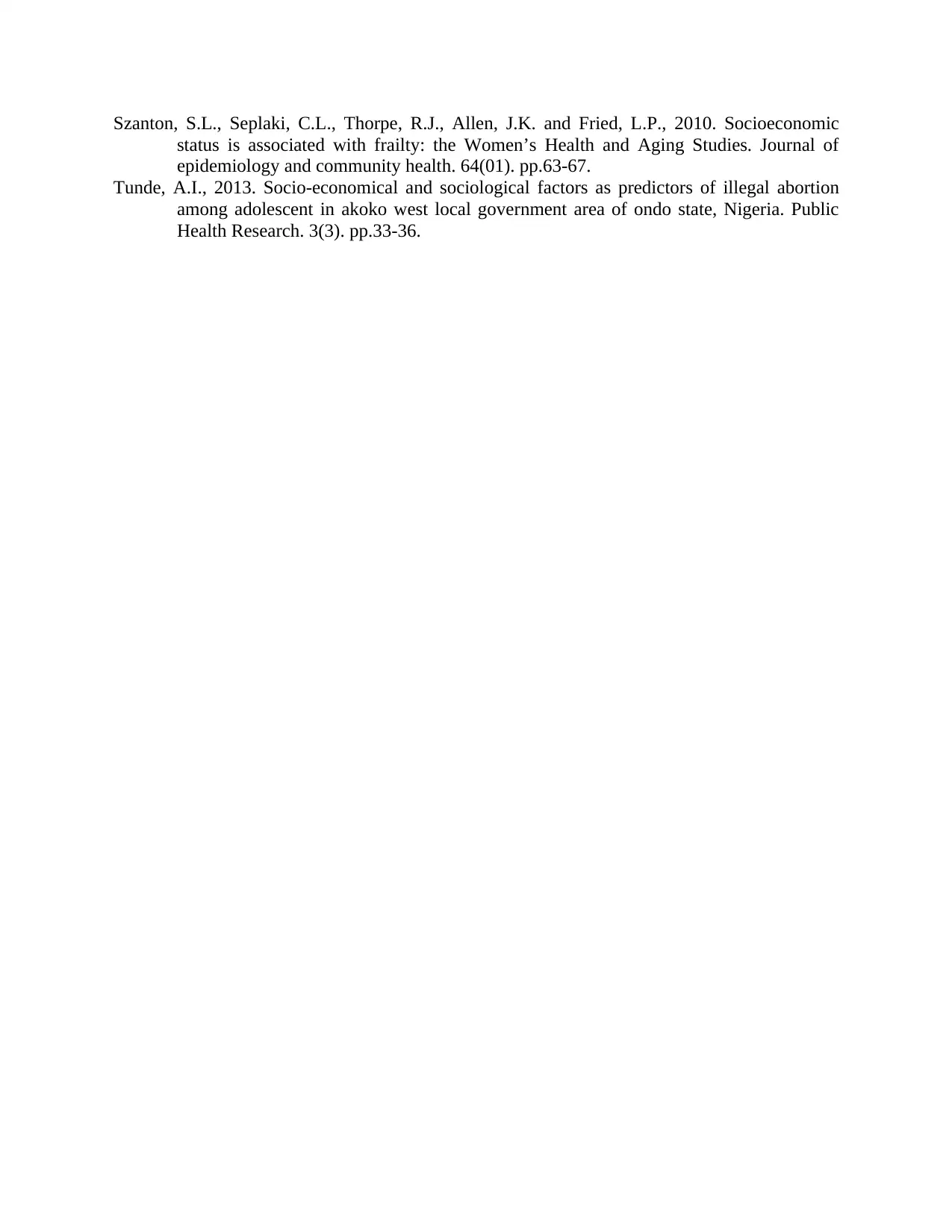
Szanton, S.L., Seplaki, C.L., Thorpe, R.J., Allen, J.K. and Fried, L.P., 2010. Socioeconomic
status is associated with frailty: the Women’s Health and Aging Studies. Journal of
epidemiology and community health. 64(01). pp.63-67.
Tunde, A.I., 2013. Socio-economical and sociological factors as predictors of illegal abortion
among adolescent in akoko west local government area of ondo state, Nigeria. Public
Health Research. 3(3). pp.33-36.
status is associated with frailty: the Women’s Health and Aging Studies. Journal of
epidemiology and community health. 64(01). pp.63-67.
Tunde, A.I., 2013. Socio-economical and sociological factors as predictors of illegal abortion
among adolescent in akoko west local government area of ondo state, Nigeria. Public
Health Research. 3(3). pp.33-36.
Paraphrase This Document
Need a fresh take? Get an instant paraphrase of this document with our AI Paraphraser


1 out of 15
Related Documents
Your All-in-One AI-Powered Toolkit for Academic Success.
+13062052269
info@desklib.com
Available 24*7 on WhatsApp / Email
![[object Object]](/_next/static/media/star-bottom.7253800d.svg)
Unlock your academic potential
© 2024 | Zucol Services PVT LTD | All rights reserved.




